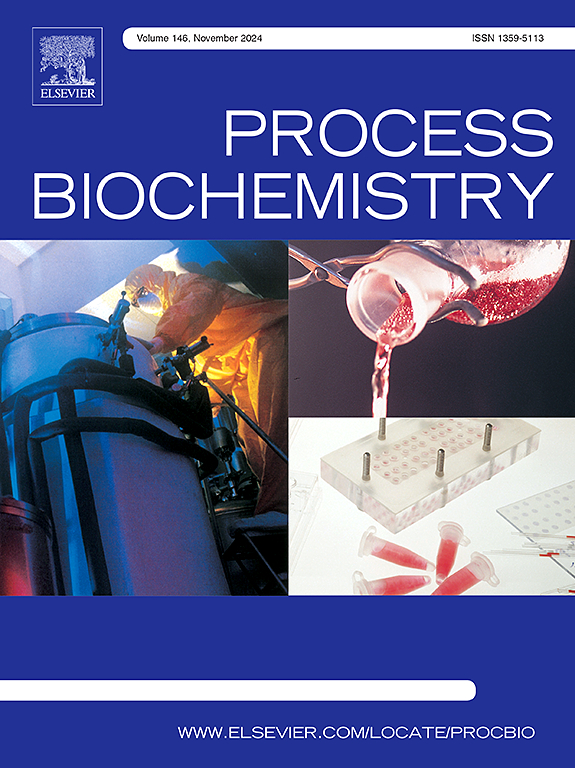曝气对混合水葫芦与移动床生物膜反应器处理低强度合成废水协同效应的影响
IF 4
3区 生物学
Q2 BIOCHEMISTRY & MOLECULAR BIOLOGY
引用次数: 0
摘要
混合水葫芦(WH)与移动床生物膜反应器(MBBR)提供了一种基于自然的抛光策略,其中曝气在决定氧气可用性、生物膜稳定性和污染物去除性能方面起着关键作用。曝气是MBBR性能的关键部分,但植物-生物膜杂交种的操作指南尚不完善。本研究研究了曝气对维持大型植物和生物膜整合的NH₃-N和COD去除性能的影响。采用WH-MBBR混合系统处理生活污水进行了两阶段的实验室规模研究。第一期不曝气,第二期持续曝气2.5 L min⁻¹ ,监测72 h。结果表明,在72 h不曝气时,NH₃-N的去除率达到88 %,而在曝气时,NH₃-N的去除率达到95-99 %。此外,在曝气条件下,COD在28 h内被完全去除,表明反应速度加快,出水水质改善。曝气是影响WH-MBBR抛光的主要因素。连续低强度曝气使氮和有机污染物几乎完全去除。这些发现提供了一个比较评估,证明了曝气在大型植物- mbbr性能中的作用,支持设计标准和选择合适的抛光DO范围。本文章由计算机程序翻译,如有差异,请以英文原文为准。
Aeration influence on synergistic effects of hybrid water hyacinth and moving bed biofilm reactor in polishing low-strength synthetic wastewater
The hybridizing water hyacinth (WH) with a moving bed biofilm reactor (MBBR) offers a nature-based polishing strategy, in which aeration plays a key role in determining oxygen availability, biofilm stability, and pollutants removal performance. Aeration is critical part to MBBR performance, however operational guidelines for plant–biofilm hybrids remain insufficiently underdeveloped. This study investigates the effects of aeration on NH₃-N and COD removal performance that sustains the integration of macrophytes and biofilms. A two-phase laboratory scale study was conducted using WH–MBBR hybrid system to treat domestic wastewater. Phase I was operated without aeration, while Phase II was operated with continuous aeration at 2.5 L min⁻¹ with 72 h performance monitoring. The results showed that NH₃-N removal achieved 88 % at 72 h without aeration, whereas with aeration it reached 95–99 %. In addition, COD was completely removed within 28 h under aerated conditions, indicating accelerated reaction rates and improved effluent quality. Aeration is the primary factor influencing WH–MBBR polishing. Continuous low-intensity aeration enables near-complete nitrogen and organic pollutant removal. These findings provide a comparative assessment that demonstrates the role of aeration in macrophyte–MBBR performance, supporting design standards and the selection of appropriate DO range for polishing.
求助全文
通过发布文献求助,成功后即可免费获取论文全文。
去求助
来源期刊

Process Biochemistry
生物-工程:化工
CiteScore
8.30
自引率
4.50%
发文量
374
审稿时长
53 days
期刊介绍:
Process Biochemistry is an application-orientated research journal devoted to reporting advances with originality and novelty, in the science and technology of the processes involving bioactive molecules and living organisms. These processes concern the production of useful metabolites or materials, or the removal of toxic compounds using tools and methods of current biology and engineering. Its main areas of interest include novel bioprocesses and enabling technologies (such as nanobiotechnology, tissue engineering, directed evolution, metabolic engineering, systems biology, and synthetic biology) applicable in food (nutraceutical), healthcare (medical, pharmaceutical, cosmetic), energy (biofuels), environmental, and biorefinery industries and their underlying biological and engineering principles.
 求助内容:
求助内容: 应助结果提醒方式:
应助结果提醒方式:


